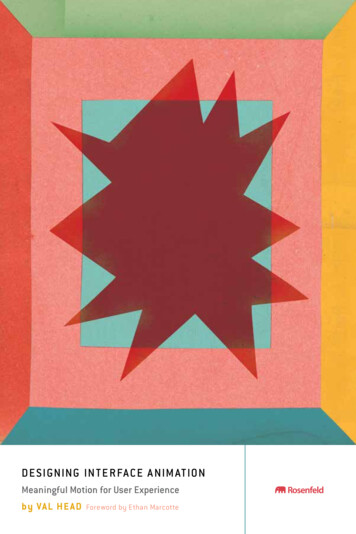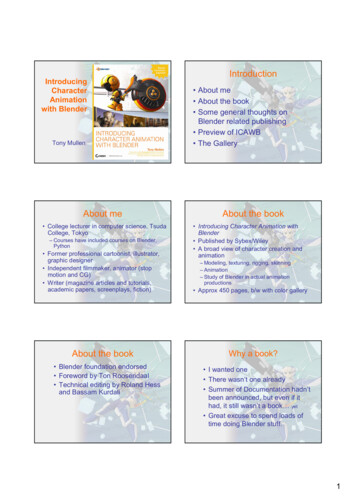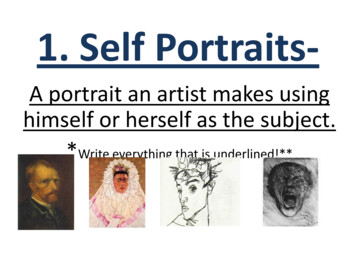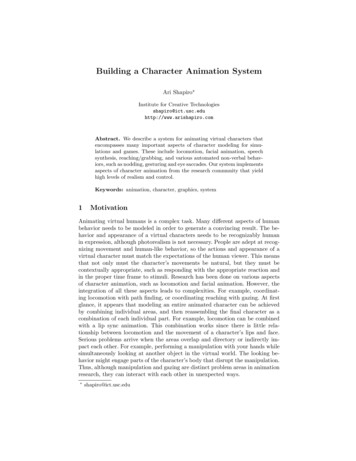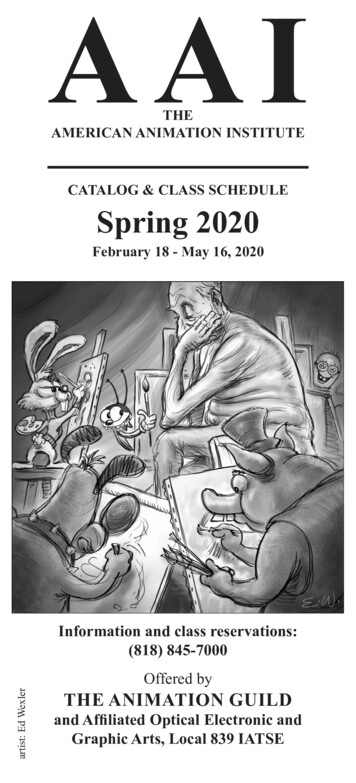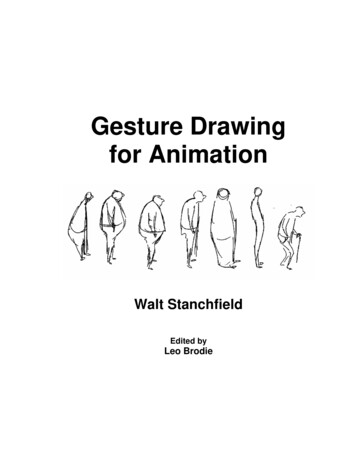
Transcription
Gesture Drawingfor AnimationWalt StanchfieldEdited byLeo Brodie
iiWalt StanchfieldThis compilation is not copyrighted or protected in any way by the editor of the compilation (LeoBrodie). It is based on a series of un-copyrighted class notes written by animation instructor WaltStanchfield during the period roughly from 1970 to 1990. Since then, these class handouts havebeen widely copied and shared amongst animation students and members of the animationindustry with Mr. Stanchfield's blessing and encouragement; in that spirit, the handouts are nowavailable freely on the Internet. Some of the illustrations in this book represent preliminarydrawings of cartoon characters that are the properties of their respective copyright holder(s) andare therefore protected by copyright. These illustrations were part of the original handouts andare included here for educational purposes to illustrate specific principles of animation technique.No endorsement of this book by the copyright holder(s) is implied, nor do the views expressed inthis book necessary reflect those of the copyright holders(s). I hope that covers it.
Gesture Drawing for AnimationiiiTable of ContentsChapter 1: Go for the Truth .2Observe, Observe, Observe.2Lead to the Emotion.4Give Them the Experience.5The Driving Force behind the Action .5Gesture .9The Essence .10Go For The Truth!.13Chapter 2: The Animator's Sketchbook .13Everywhere You Go .17Composition.17Ron Husband's Sketchbook .21Note Taking and Sketching.27Good Habits .32Chapter 3: A Visual Vocabulary for Drawing .31Lines, Lines, Lines.31A Simple Approach to Drawing .31A Simple Approach to Drawing .32Finding the Abstract.32The Solid-Flexible Model .32Figure Sketching for Animation .32The Pipe Model.33Seeing in Three Dimensions .34The Rules of Perspective .34Direction .36Problems of Drawing in Line.36Simplifying Heads .37Caricatured Head Shapes .37The Head in Gesture .38A Simple Approach to Costumes and Drapery.38Chapter 4: The First Impression .71Short-pose Sketching .71Superficial Appearance vs. Creative Portrayal .71A New Phrase: “Body Syntax” .72The "Explosive" Gesture.72Feel, As Well As See, the Gesture.76Draw Verbs, Not Nouns.77Draw with a Purpose.77Dividing the Body into Units.78"Knowing" or Searching .79Simplicity for the Sake of Clarity .79Chapter 5: Elements of the Pose.85Angles and Tension.88Applying Angles and Tension in Our Drawings.92
ivWalt StanchfieldTennis and Angles.98Straight against Curve: Squash and Stretch in the Pose .101Applying Perspective .103The Sensation of Space.105Recreating the First Impression .109Putting the Elements of a Pose Together .112Habits to Avoid .118It Ain’t Easy.121Chapter 6: Pushing the Gesture .119Drawing Gesture from the Model .120Stick to the Theme .120Subtlety .123Pushing the Gesture .124Gesture to Portray an Action or a Mood.124Action Analysis: Hands & Feet .125Learn to Cheat.125Lazy Lines.125Double Vision .125Caricature.125Chapter 7: Principles of Animation .153Drawing Principles.15328 Principles of Animation .154Drawing Calories .154The Pose Is an Extreme.154Animating Squash and Stretch.154The Opposing Force.154Connecting Actions.157Inbetweening.158Chapter 8: A Sense of Story.171A Sense of Story .171Talk To Your Audience - Through Drawing .179A Thinking Person's Art .182Acting and Drawing.187The Emotional Gesture .187Common Vs Uncommon Gestures .188Body Language .189Chapter 9: Final Words.191Creative Energy .191Osmosis.192A Bit of Introspection .194Mental and Physical Preparation .195The Metaphysical Side.196Habits .197Final Words on Essence.199
Gesture Drawing for AnimationvForeword by the EditorWalt Stanchfield was an animator who taught life drawing classes for animators with aspecial emphasis on gesture drawing. For each weekly class session, he wrote informalhandouts to emphasize the theme of the current class session, to comment on work donein the previous class, or discuss whatever topic struck his fancy. Over a period of years,these notes were lovingly shared, studied, and treasured by animators and animationstudents everywhere.Mr. Stanchfield personally gave copies of his collection to interested students, and washappy to seem them distributed. According to many people who were lucky enough tostudy under him, he wanted to publish them as a book, but the studio where he workedwas not interested.The goal of this project is to imagine the book that Walt Stanchfield might have written.This project is a compilation of the first 60 handouts that are shared on thewww.animationmeat.com website (as that site has numbered them). Walt Stanchfield didnot present his topics in any particular order, which suited the ongoing nature of theclasses. Walt's handouts are like individual frames of animation—some are extremes,some are inbetweens, some are even cleanups. As I was reading the notes and trying toabsorb as much as I could, I thought I might understand them better if it were all laid outin sequence, with basic topics followed by more complex ideas. I wanted to see his ideasgrouped by subject so I could compare the ideas. In other words, I wanted the topics to bearranged like a normal book. So I've re-arranged bits and pieces from the handouts intocohesive chapters, while taking the liberty to eliminate redundancy and make minor editsjust as a book editor would.In deciding how to organize the material, I imagined how Walt himself would have put ittogether if he'd written it. Where would he have started? Knowing that the readers of thebook would not be the lucky members of his classes, what concepts would haveillustrated before moving on to more advanced topics? I tried to follow the principlesWalt himself outlines in these notes: clarity, attention to the "essence," emotion, andusing the minimum number of words (lines) to get the point across.Another reason I wanted to see this material as a book is that there is no other book thatcovers the same information. There are many excellent volumes on animation, but theygenerally assume that the reader can already draw animatable characters with strongposes without explaining how to get to that stage. All the books on generic figure and lifedrawing, even those that emphasize gesture, encourage capturing the model's appearanceand gesture without explaining how to internalize the gesture so as to push it to extremesor apply it to a different figure. Personally, I think this compilation—if it were a book—would take its place among the top volumes on animation.There is an informal, lively charm to the original handouts that gives the reader a sense of'being there.' You may want to check them out to get a feel for how this information was
viWalt Stanchfieldoriginally presented. I've left "Savvy Sayings" (#47 in the animationmeat.com collection)out of this book, so it remains a delight that you can seek out on your own.Many, many thanks to Jon Hooper and Steve Kellener of AnimationMeat.com forscanning and transcribing many of Walt's notes and making them available on their Website. This book incorporates their scans and OCR conversions, so it would not existwithout their efforts. Thanks also to Aimee Major Steinberger, who was, I believe, thefirst person to post one of the Walt's notes on the Internet.-- Leo BrodieSeattle, Washington
Gesture Drawing for AnimationAbout Walt StanchfieldWalt Stanchfield was born in 1919 in Los Angeles,California. He is listed as animator on Winnie the Pooh andthe Blustery Day, The Many Adventures of Winnie thePooh, The Rescuers, The Fox and the Hound (coordinatinganimator), Micky's Christmas Carol (creativecollaboration), The Black Cauldron (key animationcoordinator), The Great Mouse Detective (coordinatinganimator), Roger Rabbit (animation consultant) and Oliver& Company (production assistant). He continued withDisney in later years, advising and teaching classes. Mr.Stanchfield died September 3, 2000.vii
viiiWalt StanchfieldFrom the October 2000 Peg-BoardOnce in a lifetime, a truly special teacher comes along who can change your lifeforever. To me and to many, many of our colleagues in the industry, WaltStanchfield was that very special teacher.Part artist, part poet, part musician, part tennis pro, part eccentric savant, partwizened professor, Walt inspired a generation of young artists not only with hisvast understanding of the animator's craft, but with his enthusiasm and love oflife.Walt started in the animation industry at Mintz in 1937. He also worked for twoyears at Lantz. In 1948 he went to work for Disney and with the exception of fourshort retirements, had worked there ever since. Walt worked on every full-lengthcartoon feature from The Adventures of Ichabod Crane and Mr. Toad (1949) toThe Great Mouse Detective (1986).Throughout those years Walt developed an insatiable enthusiasm for teaching thecraft. He supported his numerous drawing classes with weekly hand-outs thattaught not only animation and drawing principles, but philosophy, attitude and lifelessons.Walt's personal work was full of vitality. He was a tireless sketcher, a painter oflandscapes, seascapes, still lifes and people. He was an avid writer, penninghundreds of pages of notes about the art of animation as well as poetry andstories. He also loved music and spent an inordinate amount of time at the piano that is, between caring for his vegetable garden and playing his most belovedgame: tennis.Walt has touched many lives, not only with his endless enthusiasm for animationbut with his love of life, art and people. His work will live on forever in the handsand hearts of his students and we will all miss him.-- Don Hahn
Gesture Drawing for AnimationixIntroduction (In the Words of Walt Stanchfield)Have you ever said, “Oh, if I could just draw well”? Ah, yes, you could express yourselfto the nth degree. You could animate or cleanup scenes that would evoke oohs and aahs.Work wouldn’t be so much like work.You could get it all down on paper and leave at 5:00 o’clock feeling good.Sometimes I wish I had a magic wand that I could wave over you and say, “You are nowlearned artists—go and draw to your hearts content.” But maybe it’s better that you do ityourself—become your own self-starter. The learning process should be fun. One thingthat it does is it tears down a lot of false pride. To seek help is a humbling experience, avery necessary one, in as much as animation should be thought of and practiced as agroup effort. I consider a person who is not ashamed to seek help a wise person.I got a late start in life. The first five or six years in the business were a “walk through.”(I started at Mintz’s Cartoon Studio on Sept. 13, 1937.) I was a dilettante, toying withpoetry, painting, singing and socializing. Then 10 years as Lounsbery’s assistant, and 10years as Johnston’s assistant helped me to “center” myself. Those guys worked hard andwere completely devoted to their jobs. That taught me to work hard (and study hard tocatch up). The next 20 years were not easy but were very satisfying.Having been brought out of retirement for the fourth time, I have been trying to impartsome of the drawing know how I have gathered in these past years. I have incorporatedthe weekly “handout” which I think works better than lectures. They allow me to morethoroughly express the salient points that come to mind. What’s more, they are“collectables” that, in the future may be reviewed when the need arises.These handouts allow me to delve deep into my experiences and observations and comeup with something that may be of help to you. I have concentrated on gesture drawingbecause that is one of the foundations of good animation. Necessary to good gesturedrawing are acting, caricature, anatomy, body language, perspective, etc., so from time totime these topics are isolated and discussed.At times I even play the “guru” and deliver a sermon of a positive thinking nature.I have struggled to avoid referring to myself as a "teacher" and have used words like"suggestion" rather than "correction" when offering another version of a pose. I'm reallyhere just to share my experience and it's your prerogative to treat it however you see fit.As for the suggestions, they are only to encourage you to see in new ways, to help youbreak any stultifying habits of "penny-pinching" seeing. I feel that the classes I conductand the handouts, if nothing else, create a surge of group energy that you might tap foryour own personal betterment.I once told the class, "These things I present are not esoteric concepts." But I waswrong—they are. They are things that only the chosen few absorb. It is the "chosen" few
xWalt Stanchfieldthat lead the way and accomplish the "academy-award-worthy" animation and drawing.But it is my conviction that by earnest pursuit, anyone can be of that group. It's just amatter of exposing oneself to some vehicle that will help one break the "sound barrier"(actually, thought barrier, for drawing is a thinking person's art).Here's a caricature by Dan Haskett that captured the spirit of my "Teaching" many yearsago at the "Disney School of Animation". It's quite a prophetic drawing too, for out in theaudience are two of your current directors - Clements and Musker. Spot any others?Maybe Jerry Reeves? Ed Gombert? Bluth, Pomeroy and Goldman? Even the artisthimself is there - Dan Haskett.Different faces out there now but the sentiments are the same.In the Illusion Of Life, Ollie or Frank had written a paragraph on cleanup people whichlists some of the functions of a cleanup person which coincide with some of the things Ikeep stressing in the drawing class: a crisp line against a soft shape (using angles),designing shapes that work with the action rather than copying, emphasizing squash andstretch, and drawing detail only as it furthers the action and the drawing. Especially,“telling the story” whether it’s a scene of animation or a still drawing.
Gesture Drawing for AnimationxiThe quote, reprinted here in full, refers to cleanup people but it could as well refer toanimators and inbetweeners. All of the above classifications make drawings that go into ascene, and so the same training is necessary for all.“They studied line drawing, training on Holbein, Degas, Daumier, Da Vinci; theywatched drapery in movement, noting the difference between filmy scarves, woolenskirts, flowing capes, and even baggy pants; they learned the value of a sharp, crispline against a large, soft shape; they knew how to keep a design in the free-flowingchanging shapes of animation rather than make a rigid copy. They always extendedthe arcs of the movement, squashed the characters more, stretched him more –refining while emphasizing both the action and the drawings. They understood thebusiness of the scene, what it was supposed to achieve, worked closely with theanimator in deciding which parts were developing well and which parts needed a littlehelp, and they could see the characters start to live as they “rolled” the drawings onthe pegs. This required a special kind of talent as well as study – not every artist couldmaster it.”So you see, there is something special about the thinking that goes into animationdrawing.Don’t ease up on your search. Success is just around the proverbial corner.May the forces and stretches and angles and all other drawing helps be with you.
xiiWalt Stanchfield
Chapter 1: Go for the TruthObserve, Observe, ObserveAnimation! This is the vehicle you have chosen to express yourself in. A whole list of"tools" are required: drawing, timing, phrasing, action, acting, pantomime, staging,imagination, observation, interpretation, logic, caricature, creativity, clarity, empathy, andso on—a mind boggling array of prerequisites.Rest at ease. You were born with all of them. Some of them may need a little sharpening,others may need to be awakened as from a deep sleep, but they are as much a part of youas arms, legs, eyes, kidneys, hemoglobin, and speech.Reading and observing are two emancipators of the dormant areas of the mind. Read theclassics, biographies, humor, mysteries and comic books. Observe, observe, observe. Belike a sponge—suck up everything you can lay your eyes on. Look for the unusual, thecommon, characters, situations, compositions, attitudes study shapes, features,personalities, activities, details, etc.Draw ideas, not things; action, not poses; gestures not anatomical structures.I am reprinting some ruff animation drawings to remind you of the style of drawing thatseems to serve the purposes of the animators best—loose andexpressive.1
Gesture Drawing For Animation2
Chapter 1: Go For the Truth!Lead to the EmotionA well constructed drawing should have all the parts and they should be put togetherbeautifully, but that is not what you should see when you look at the drawing. What youshould see is the emotion. In a drawing of a starving man you should see fear and hungerand despair, and you should feel this, plus pity and revulsion and anger. All gestureswon’t be quite that dramatic, but all gestures are certainly more than their parts.Do this experiment: get a wooden match and look at it. That represents your model or,character in animation. Then light it and let it burn half way. Now it represents yourmodel or character in gesture.It has been transformed from the anatomical match into a burnt match. If you had to drawa burnt match you wouldn't say to yourself, "Okay, this is the anatomy of a match." No,you would say, "This is a match whose anatomy has been burnt and twisted into anagonizing shape. A shape that if I imagine myself being in that state—if I feel what hashappened to that match has happened also to me—then this is the feeling that I have todraw, to portray."We must be emotional about our subject whether it has to do with serious matters or withhumor. We cannot back off from our emotions – if we do the result will he a mereanatomical reproduction. A drawing or a scene is not final when a material representationhas been made; it is final when a sensitive depiction of an emotion has been made.The significance is not in the story alone, but in the illustration that makes that storycome alive. Yes, there is anatomy, form, construction, model and two or three lines ofetceteras, but only in so far as those things are expressive of the story.3
Gesture Drawing For AnimationGive Them the ExperienceDrawing for animation is not just copying a model onto paper; you could do that betterwith a camera. Drawing for animation is translating an action into drawing form so anaudience can retranslate those drawings back into an experience of that action. You don’tjust want to show the audience an action for them to look at it. You want to visualize anaction for them to see – that is, to experience. That way you have them in your grasp,your power, and then the story can go on and the audience goes on with it, because theyare involved. You have allowed them to experience it.The parts of the figure must be put together in a manner that will portray or caricature themeaning of the pose. Otherwise it will be just a drawing. What a horrible fate – to be justa drawing.Here are some animation drawings that have transcended the anatomy and model of thecharacters. They are good drawings, but not just drawings.The Driving Force behind the ActionIn drawing sessions, I try to direct the students' thoughts to the gesture rather than to thephysical presence of the models and their sartorial trappings. It seems the less the modelwears, the more the thinking is directed to anatomy, while the more the model wears, themore the thinking goes into drawing the costume. It’s a deadlock that you can only breakby shifting mental gears from the “secondary” (details) to the “primary” (motive ordriving force behind the pose). Remember, the drawing you are doing in class should bethought of as a refining process for your animation drawing skills.I found something in Eric Larson’s first lecture on Entertainment, which may be of helpto you. Please bear with the length of the quote; it is put so well I couldn’t edit it withoutlosing some of the meaning. As you read it, keep your mind on gesture drawing.“. As we begin the ‘ruffing out’ of our scene, we become concerned with thebelievability of the character and the action we’ve planned and we give some4
Chapter 1: Go For the Truth!thought to the observation of Constantin Stanislavsky. ‘In every physical action,’he wrote, ‘there is always something psychological and vice versa. There is noinner experience without external physical expression.’ In other words, what isour character thinking to make it act, behave and move as it does? As animators,we have to feel within ourselves every move and mood we want our drawings toexhibit. They are the image of our thoughts.“In striving for entertainment, our imagination must have neither limits norbounds. It has always been a basic need in creative efforts. ‘Imagination,’ wroteStanislavsky, ‘must be cultivated and developed; it must be alert, rich and active.An actor (animator) must learn to think on any theme. He must observe people(and animals) and their behavior—try to understand their mentality.’“To one degree or another, people in our audience are aware of human and animalbehavior. They may have seen, experienced or read about it. Their knowledge,though limited, acts as a common denominator, and as we add to and enlargeupon said traits and behavior and bring them to the screen, 'caricatured and alive,'there blossoms a responsive relationship of the audience to the screen character—and that spells “entertainment.'“How well we search out every little peculiarity and mannerism of our characterand how well and with what 'life' we move and draw it, will determine thesincerity of it and its entertainment value, we want the audience to view ourcharacter on the screen and say: ‘I know that guy!’ (or in the case of gesturedrawing: ‘I know what that person is doing, what he or she is thinking.’)Leonardo da Vinci wrote: ‘Build a figure in such a way that its pose tells what isin the soul of
Sep 03, 2000 · Walt started in the animation industry at Mintz in 1937. He also worked for two years at Lantz. In 1948 he went to work for Disney and with the exception of four short retirements, had worked there ever since. Walt worked on every full-length cartoon feature from The Adventures of Ichabod C

